India Water Bombed Pakistan – Flood Analysis 2014
0 comments | by Samson S Sharaf

This year’s floods in IHK (Indian Held Kashmir) and Pakistan caused by unprecedented rains in the upper riparian of rivers Jhelum and Chenab will remain a mystery for researcher’s world over. The world’s steepest slope that descends from 8 KMs to a few hundred meters within a lateral distance of 300 miles warranted better vigilance, water regulation and early warning. The fact that water management authorities on both sides of the divide are making lame excuses to cover unprofessionalism and lack of urgency to harness the fury of rushing waters needs no opinion. Amidst this widespread destruction, the Metrological Department of Pakistan (MET) and its Flood Forecasting Division (FFD) emerged as the most efficient organization whose alerts fell on deaf ears on both sides. Their forecasts will remain a thorn for the governments of India and Pakistan.
Despite the fact that all river systems of Indus Basin flow out of IHK, Central Water Commission (CWC) of India does cover Kashmir. CWC’s website features 18 level and eight inflow forecasts with Kashmir excluded. In the absence of government mandated prerequisites, there are no forecasting stations. Out of 175 flood forecasting stations run by CWC none lies in IHK. Whether failure at forecasting and regulation was deliberate or due to systemic failure is a subject of heated debate in IHK and India. Silence of CWC and State Regulatory Authorities rings alarms. The disaster management authority in IHK is inoperable.
In Indian held Kashmir, there were no warnings. By 6 September over 200 had died and over 80,000 evacuated. A year earlier the Uttarakhand cloud burst that left more than 5,700 dead and hundreds of thousands stranded went unnoticed. So who controls and regulates over 50 water structures in IHK is anybody’s guess. What is known is that IHK government exercises no control over it.
On 22nd August 2014 the Indus River System Authority (IRSA) warned the provinces of about 20 percent water shortfall for the Rabi crops. This warning came despite alerts by the Metrological Office of Pakistan on 14-15 August of medium/high level floods in Ravi and Chenab catchments. From 3-5 September 2014, the Met office issued repeated flash alerts of exceptionally high floods in Rivers Jhelum, Chenab, Ravi and its catchment. But neither the Ministry of Water and Power nor Indus River System Authority (IRSA) that regulates the dams and barrages reacted. Mangla Dam was filled to 1236.6 MAF while gates at Head Rasul, Khanki and Qadirabad remained closed storing water upstream that should have been released and which later became the FLOOD.
Here are some astonishing statistics.
On 4 September 2014, the inflow at Mangla was 95,000 against a discharge of 30,000 cusecs. Inflow of Chenab at Marala had reached 137,000 cusecs. Mangla was being filled while Chenab was registering a low flood.
On 5 September 2014, Mangla continued to be filled by an exceptionally high inflow of 310,000 cusecs with a discharge f 15,000 cusecs. Someone in Pakistan’s water management system was not monitoring Rivers Jhelum and Neelam in Azad Kashmir. Had they, discharge at Mangla would have commenced earlier enabling water from Head Rasul to reach Trimmu before the water from Marala, Khanki and Qadirabad reached there. Meanwhile Chenab at Marala had reached exceptionally high levels of 485,000 cusecs. It never dawned on IRSA that any later discharge of water from Mangla would complicate the flood situation at Trimmu Barrage and downstream.
On 6 September, IRSA released 282,000 cusecs from Mangla against an inflow of 413,000 cusecs. The gates at Khanki and Qadirabad on Chenab were not fully opened registering a surge of over 650,000 cusecs. Had these gates been opened on 5September, the separate surges at Jhelum and Chenab would have successively passed Trimmu, reducing flooding. The delay in alternatively opening gates at Head Rasul and Khanki-Qadirabad meant unprecedented disaster if two surges at Trimmu combined after 7 September.
By 7 September, the flood surge at Jhelum had reduced and Mangla was full to capacity. By 9 September the inflow of Chenab at Marala was down to 85,000 cusecs. A huge mass of water equivalent to two or more Mangla Dams was trapped between manmade and man regulated structures from Head Rasul and Khanki-Qadirabad to Trimmu. This was to wreak havoc downstream. Through human manipulation/error an avoidable flood situation was created upstream of Trimmu on Jhelum and Chenab. Incidentally the IRSA Daily Water Situation Report has no columns for Khanki, Qadirabad and Trimmu, an omission that may have led to their miscalculations. Yet, had IRSA and WAPDA paid heed to Daily Flood Situation Reports of Federal Flood Commission and Flood Forecasting Division, the calamity was avoidable limiting damage. There was ample information that was not acted upon.
But what about Pakistan’s flood management?
First, IRSA preoccupied by the pressures to appropriate water to provinces was more inclined to fill Mangla Reservoir despite flood warnings in August and September. When it did release 282,000 cusecs of water at 6 Am on 6 September, it did not take notice of the exceptionally high flood of over 480,000 cusecs at Marala and downstream at Khanki/Qadirabad (over 600,000 cusecs). Had the water been incrementally released between 4 and 5 September, a massive surge at Trimmu could have been avoided.
Secondly, it is strange why the management failed to open the flood gates at Marala till 5 September and why the gates at Khanki and Trimmu were kept in regulation and not flooding mode as late as 7 September?
Who will now take responsibility for storing an unprecedented volume of water (more than two Mangla Dams) from Rivers Jhelum and Chenab at Rasul Headwork, Khanki and Qadirabad and then releasing it to simultaneously threaten Trimmu and the flood protection bunds along it?
Why are the Federal Minister for Water and Power and Prime Minister terming the floods as beyond expert assessments when data released by monitoring and forecasting organisations point towards human factors?
Why is the Indus Water Commission with co-chairs from Pakistan and India dodging the issue of flooding and why are India and Pakistan preparing to take a joint stance on the issue?
There is certainly more to bite than one can chew. The damage to infrastructure, agriculture, human lives and populations is beyond imagination. In the final analysis, most of it was man made and avoidable. Who will take responsibility?
All cited data has been taken from IRSA, Flood Forecasting Division Pakistan, Ministry of Water and Power Pakistan, Metrological Reports of Pakistan, CWC India and thethridpole.net





